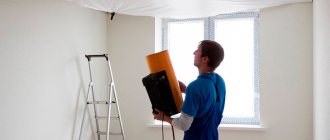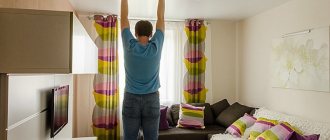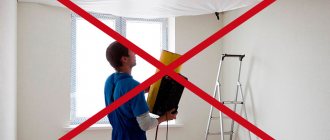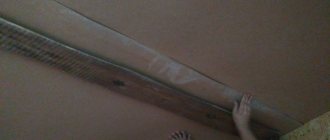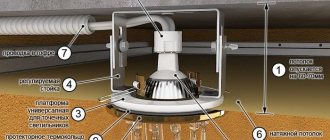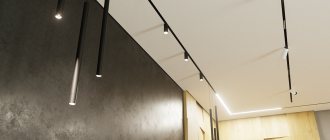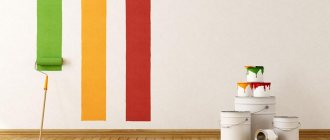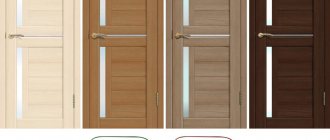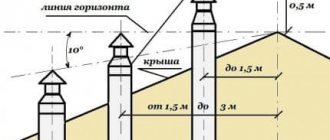Tension fabric is the most promising material for decorating the ceiling space in an apartment or office. It provides a perfectly flat surface, has high performance characteristics and durability. Installation of a stretch ceiling is possible in renovated premises; it is carried out within 2-3 hours, does not involve wet processes and does not require a radical rearrangement of furniture. A variety of textures and colors, multi-level designs, prints and the use of special effects create unlimited possibilities for design solutions. Which canvas is better to choose? When purchasing, you should focus on the specifics of the premises, personal preferences and financial capabilities.
- Blade type
- Texture
- Company manufacturer
- Color
- Room
- Lamps
- Cornice
- Ceiling "starry sky"
- "Floating" ceilings
- Stretch ceilings in a country house
Differences in installation technology
As already mentioned, the properties of vinyl and fabric canvases have some features.
This is the reason for the difference in installation technology. Any PVC stretch ceiling requires heating. A gas gun is usually used for this. A stream of hot air is directed directly onto the canvas. At the same time, the room temperature rises to +60 °C. The elasticity of the film increases and it is easy to stretch it to the required size. Then a special fastener welded along the edges - a harpoon - is tucked into a profile pre-installed around the perimeter of the room. This type of fastening is used only with PVC film. Installation begins from the corner marked by the ceiling manufacturer and continues gradually in both directions along the entire perimeter.
Subsequently, as the room cools, the canvas is tensioned. For this type of ceiling, the accuracy of the measurements is especially important. Cutting the film for a stretch ceiling is carried out using special software. And the finished ceiling is approximately 20% smaller than the area of the room.
Polyester, on the other hand, tends to shrink when heated. Therefore, the installation of a fabric stretch ceiling is carried out without a heat gun and preliminary cutting. A roll of the required width is unrolled right on the spot, and the excess is cut off after stretching. They begin to tuck the fabric into the baguette first on the walls (primarily on the short ones), and only then tighten the corners. Heat may be needed here - in some cases, when stretching the fabric, minor folds form in the corners. It is enough to warm them up a little with a hair dryer so that the material straightens out and acquires a smooth surface. But as a rule, experienced craftsmen do without heating.
Stage two. Design
To prepare a suspended ceiling project, you can use a special architectural program that allows you to obtain an accurate design diagram with the exact number of consumables. If you plan to do everything the old fashioned way, that is, on paper, then be prepared for the fact that it will take more time and effort.
Step 1 . Determine the perimeter of the ceiling using a special formula. For example, if the room measures 3x5 m, then the calculation will look like this:
(3 + 5) x 2 = 16 (m)
The number you get in the end will also be the length of the guides. Transfer your results onto graph paper.
Important ! If the lengths of opposite walls are different (and this also sometimes happens), take a larger value as a basis.
Step 2 . Calculate the frame profile. It will be a 6x2.7 cm profile, which you will fasten in increments of 60 cm. It is important that the length of one profile is the same as the width of the room. To calculate the number of planks, divide the width (300 cm) by the indicated pitch (60 cm). That turns out to be 8.3, round it up to 8.
The outermost planks should be fixed 10 cm from the walls, the rest - with the step indicated above. By the way, the step of 60 cm is not accidental - the fact is that the standard width of plasterboard sheets is 60 or 120 cm. Indicate the location of the planks in the project.
The main profiles are marked with a red line, the load-bearing ones with a blue line, and the hanger attachment points with gray circles.
Step 3 . Determine how many hangers are needed (their mounting step is also 60 cm). It turns out that 300 needs to be divided by 60 and multiplied by 8 - equal to 40 pcs. When installing the first and last hangers, you need to retreat 30 cm from the wall. In the project, indicate the places where the hangers will be located with crosses.
Expert opinion
Sergey Svistunov
Specialist in the design of buildings and sewer systems. Knows everything about construction and renovation.
Typically, preference should be given to spring suspensions. While straight lines can only be used if the ceiling surface is absolutely flat or if the height of the suspended structure is more than 12 cm.
Step 4 . Calculate how many connecting jumpers are needed (they are used to increase rigidity):
((300/60) – 1) x 8 = 32 pcs.
Step 5 . The last step is to calculate the number of sheets and screws. There is nothing complicated here, because you already know the total area of the room (15 m²), while the area of one sheet is 3 m² (can be determined by size). It turns out that for such a room you need to purchase 5 sheets of drywall.
To calculate the number of screws, consider the following:
- you will need 6x60 screws for the ceiling (step – 60 cm), walls (step – 30 cm);
- drywall will be fastened in “thirties” (step – 25 cm);
- To fix the fittings, you will need self-tapping screws LN-11 (2 pcs for each suspension, profile, 4 pcs for “crabs”).
On a note ! After this, mark the lighting fixtures in the project, and also calculate the amount of electrical wiring.
Which option to choose
So which is better - fabric stretch ceiling or PVC? Perhaps the question posed in this way is not entirely correct. It is more correct to ask: “Which ceiling is best suited to a particular room?” In any case, a compromise will be required between operating conditions and personal aesthetic preferences.
The comparison table below will help you make the right choice.
| Properties | Film | Textile |
| Strength | PVC is a tear-resistant and elastic material, but it can be easily damaged by any sharp object. | Fabric sheets are denser and stronger, practically do not stretch, and are difficult to damage mechanically. |
| Permissible temperature range | The film is used at temperatures from +40 to -5 °C; use in unheated rooms is unacceptable. | Fabric sheets can withstand from +80 to -50 °C; installation in unheated rooms (country houses, dachas, balconies) is allowed. |
| Degree of sagging over time | 0 – 30 mm | 0 – 10 mm |
| Moisture resistance | PVC is a waterproof material; when flooded from above, it can withstand up to 100 liters of liquid for a long time; after its removal, the original appearance of the film is restored; it is recommended for wet rooms. | Low moisture resistance: installation in the bathroom and kitchen is undesirable with a ceiling height of less than 2.7 m, increased requirements for ventilation. After flooding, leaks begin within 2 hours; subsequently, stains and stains that cannot be removed may remain. |
| Soundproofing | Absent, the film can even slightly increase the noise from neighbors, the “echo” effect. | Low, however, there are special acoustic types of fabric stretch ceilings that eliminate the “echo” effect. |
| Thermal insulation | Absent. | Low, it will not play a special role without additional thermal insulation materials. |
| Width size range | 130-600 cm (European production - up to 325 cm) | 150-510 cm |
| Installation features | Heating the canvas to 60 °C using a heat gun, increased requirements for the installation team personnel and safety measures. | Without using a heat gun. |
| Environmental friendliness | Safe for health and the environment. | |
| Fire resistance | They melt and ignite if exposed to open flame for a long time. | Melts and does not support combustion. |
| Design | The widest possibilities for design solutions: glossy shiny, matte and satin surfaces, embossing, bright and moderate tones and shades of all colors, excellent photo printing, the ability to install multi-level, decorative perforated, translucent, transparent canvases and many other options. | A more modest range of colors, soft, soft tones, only matte texture, fabric texture with a flat surface. The small choice is compensated by a noble, even aristocratic appearance. Can be painted up to 5 times. Photo printing is also possible, but it does not look as bright. |
| Features of care | Easy to clean from dirt. Washing with chlorine-free detergents is acceptable; abrasive cleaning agents are unacceptable. | Fabrics are antibacterial and dirt-repellent. They can be easily cleaned only from surface contaminants. |
| Service life (warranty) | 10-12 years | 10-12 years |
| Price per m2 | 350-700 rub. | 800-1500 rub. |
Thus, suspended ceilings of different types, despite similar designs, have a unique set of properties and features. Which of them is the best in a particular case must be decided, taking into account the operating conditions of the room, the characteristics of the paintings and personal preferences.
Proposed solutions optimal sequence of work
Action steps:
- wall preparation;
- installation of a baguette;
- wallpapering;
- installation of tension film.
This sequence is considered optimal because a number of disadvantages are eliminated:
- baguettes are fixed to leveled walls without cracks or gaps;
- after installing the baguette, the resulting dust is quickly removed;
- The wallpaper is easy to glue and paint without fear of staining the ceiling. Each fragment can be easily adjusted to fit a baguette, since all defects are hidden by decorative inserts;
- after a week, the walls are completely dry, then covered with a protective layer that prevents dust and damage. Installation of the ceiling material is carried out without fear of its deformation.
Reference
Fabric ceilings do not require the use of heat guns, which protects the ceiling and wall surfaces. Without heating, the canvas is evenly distributed around the perimeter of the room. A unique sublimation of the ceiling and a new design style is created.
Defects when gluing wallpaper
Wallpaper peels off near trims and baseboards. The process occurs due to poorly applied cluster.
Poor adhesion of wallpaper near the window occurs due to high humidity in the room or a slight draft. Glue is applied again to the poorly glued fragment, and part of the wallpaper is pressed firmly against the plane of the wall.
When blisters and wrinkles appear, there are two ways to solve the problem:
- re-gluing a new canvas;
- in the middle of the swelling, a puncture is made using a thin needle, and the unevenness is smoothed out with a roller.
Thick seams appear if the seams are not cleaned enough or the fabric is glued overlapping. In this case, the canvas is re-glued.
The inclusions under the wallpaper are striking. If the particle size is significant, re-gluing is necessary. The wall is thoroughly cleaned, only good quality paste is applied.
The old wallpaper is visible through the new wallpaper. This happens because the finishing material is too thin or is made by the manufacturer with aniline dye. The only solution is to re-glue it.
Types of stretch ceiling defects:
production
an insignificant hole that appears due to the use of low-grade fabric. Unfortunately, it is very difficult to detect before installation work;
assembly
The joint areas of the baguette must be sealed with paper tape to maintain the continuity of the fabric. Gas and water pipes are handled using a polypropylene element. When fixing a lighting device, it is necessary to glue the protective thermal ring and fasten the embedded element in the ceiling opening;
operational
Proper use of the ceiling prolongs the life of the product.
Mechanical damage. Piercing and cutting objects will damage the surface of the ceiling.
Increased fragility. Due to temperature changes, the surface becomes more vulnerable.
Increased level of plasticity. For a light source, the power consumed does not exceed forty watts.
Dirt from the surface is removed using a flannel cloth.
Pros and cons of suspended ceilings
Advantages and disadvantages are determined by the type of coating used - PVC film or fabric ceilings.
But there are a number of common advantages:
- Finishing speed. Films are stretched for 4-10 hours, fabric - 5-12 hours.
- Saving the interior. Film coatings are capable of retaining large masses of water for a long time; fabric material is less waterproof, but can prevent the risk of spillage for 2-3 hours.
- There is no need to carry out leveling work on the ceiling plane. All defects, as well as communication pipes and beams in private houses, will be covered with canvas.
- Insulation and insulation materials can be laid under PVC and woven suspended ceilings.
Versatility. You can stretch fabrics in any room or building
It is important to choose materials that provide the desired level of comfort and meet the stated requirements for the use of space. Easy to care for. Cleaning is required no more than once every 6 months
Dry, wet cleaning is sufficient. If persistent stains appear, use conventional non-aggressive detergents.
Variability of color solutions, design formation, affordable price are additional advantages of finishing. It is also worth noting the long service life of the canvases, environmental friendliness and the possibility of using finishing in rooms with high requirements for the cleanliness of facing materials - in children's rooms, hospitals and other facilities.
The disadvantages of suspended ceilings depend on the type of fabric chosen:
- film coverings cannot be installed in open spaces in areas with a possible decrease in temperature;
- It is better not to use fabric sheets in rooms with high humidity levels;
- PVC films for ceilings are welded to be stretched over large areas;
- The maximum power of luminaires for suspended ceilings is no more than 40 watts; installation of a thermally insulating lampshade is mandatory.
When considering the pros and cons of suspended ceilings, it should be noted that it is necessary to involve a specialist to carry out the finishing. Do-it-yourself tensioning is possible, but the master will need special tools and experience, and no one can guarantee high-quality tension. It’s easier to use the services of professionals and get guarantees for all types of work.
Where are stretch ceilings used?
High-quality suspended ceilings can be used in any buildings, houses, rooms, but there are some peculiarities - films are best used in warm spaces, but woven fabrics are best used in areas with minimal moisture content, but woven materials do not deteriorate under the influence of negative temperatures.
Application area:
- private houses made of any materials;
- apartments;
- warehouse and public buildings;
- offices;
- commercial buildings;
- construction of entertainment complexes, including swimming pools, sports and concert halls;
- educational institutions and others.
There is not a single building where tension fabrics cannot be used. Fabric materials will be an ideal solution for open areas of balconies, loggias, terraces, as well as in storage rooms, basements and underground parking lots. The structures are lightweight and do not weigh down floor slabs or load-bearing beams. If the choice is made correctly, the owner receives a fireproof, environmentally friendly and aesthetic coating that will last for several decades without the need for repairs or renovation of the ceiling surface.
Manufacturers, price
The cost of PVC film is set by the manufacturer; it also depends on the type of fabric. But in order to fully calculate the work, it is necessary to take into account that the profile, external corners, niches, lining of pipes, columns, pulling of electrical wires, and installation of lighting fixtures are paid separately.
More information about the cost of suspended ceilings can be found on the “Calculator” page.
A comparison of PVC and fabric suspended ceilings by price indicates that they are insignificant. For many, this type of ceiling finishing is affordable, given that it will serve for a long period, without additional repairs or painting. The cost of the canvas depends on the manufacturer. It’s good if the material (film, fastenings, profile) is purchased from one company.
Beautiful examples in the interior
The ceiling does not necessarily have to have a perfectly smooth surface. The relief and figured ceiling looks very original and stylish. In this case, aluminum slats of similar shades were used. This ceiling is resistant to high temperatures, is not afraid of moisture and provides excellent air circulation. In addition, the design is easy to maintain and will last for several decades.
The universal and most popular ceiling color is white. Beige or cream is less commonly used. But a colored or dark ceiling also looks great in some styles
But it is important to be able to combine it with the overall style of the interior.
When choosing suspended ceilings, you need to decide which option you like best - matte or glossy. A shiny, almost mirror-like gloss finish perfectly expands the space. And matte hides the seams between the canvases as much as possible. But in some cases it is not necessary to mask the seams. This can become a kind of highlight of the interior. So, for example, a satin white ceiling with black stripes looks laconic and stylish in a modern living room interior.
The ceiling can serve as a continuation of the overall concept of the room or become a unique work of art. You can apply an unusual pattern, ornament or even photographs to the surface.
If the area of the apartment does not allow you to use and burden a small space with voluminous multi-level structures, and the interior style needs to be supplemented with figured and carved elements, pay attention to stretched fabrics with patterns. This is a great way to put a modern twist on the classics.
Suspended structures can look advantageous in many interior styles. And the loft is no exception. Hidden LED lighting above the suspended structure highlights the natural roughness and unevenness of the concrete floor and creates the effect of being in an industrial production room.
Fans of non-standard design solutions will appreciate ceilings that are unusual in shape and style. An option is considered stylish when the design of the hanging system is combined with shelves, niches, furniture or other decorative elements. For example, a non-standard solution is a ceiling that complements the design of a staircase in a country house.
You can watch a master class on installing a cassette ceiling in this video.
Stretch PVC ceiling
Considering what types of suspended ceilings there are, one cannot help but pay attention to PVC film materials. These are products welded from individual strips that are stretched using heat. The film itself and the air in the room heat up; after cooling, the film takes the desired shape. The texture and color scheme depend on the chosen material.
Types and characteristics
Manufacturers offer the following types of PVC films:
- Glossy. Reflective material. You should think through the area where the weld will be placed in advance so that it is not noticeable.
- Matte. An inexpensive type of material that does not have reflective properties, in its finished form resembles an ironed whitewashed ceiling.
- Satin. The middle type of material between glossy and matte film. Satin fabrics reflect light, but at the same time refract and scatter the rays, which looks especially aesthetically pleasing. Satin fabrics are produced in a wide variety of colors.
The main characteristic of PVC film that influences the choice is the width of the strip, which does not exceed 5 m, therefore, when finishing spacious ceilings, the strips are welded.
The list of reliable manufacturers is small:
- Pongs, Germany. Unique seamless ceilings under the Descor brand. The thickness of the products is up to 0.3 mm, increased strength - the canvas can withstand up to 150 liters of liquid per 1 m2.
- PTCM, Belgium. The width of the canvas is 5 m, a wide choice of colors and textures. The Belgian manufacturer offers canvases with photo printing and a 3D effect. High-quality products are distinguished by their durability, resistance to dust and dirt.
There are also manufacturers from the Russian Federation, China, and Turkey. But when choosing materials, you need to request certificates of conformity and look at the description - there is a high risk of getting defective fabrics with low performance indicators.
Cost and service life
On average, the price of installation of PVC panels starts from $8-15 (600-1200 rubles) per 1m2
It is important to consider the type of material, the shape of the structure, the presence of built-in lighting and other nuances. Manufacturer's warranty 15 years, service life from 20 years
Glue ceiling
The adhesive finishing method involves attaching the coating directly to the base using a special glue. The most used materials for this method are panels or tiles made of polystyrene foam. These tiles are characterized by their low weight (about 0.4 kg/m2), they are easy to cut, which makes it possible to use them in rooms of non-standard shape. Polystyrene also includes properties such as heat and sound insulation. However, the disadvantages of this material are that when glued end-to-end, the panels do not form a visually solid coating. To some extent, this has become the reason for the unpopularity of this type of finishing recently. However, with the advent of glass wallpaper, the method of pasting with wallpaper came back to life. Fiberglass wallpaper is very moisture resistant. Thanks to its long service life (20 years) and the ability to be painted 10-15 times, this material occupies a leading position on the market. In addition, the adhesive method is very easy and quick to implement, and also masks unevenness, cracks and other damage to the base ceiling. The usual thickness of the coating is 10 mm, and thanks to this particular characteristic, this coating can be used in rooms where the ceiling height reaches only 2.5 - 2.6 m. But there are also some disadvantages of the adhesive method: with its help it is possible to hide only minor defects horizontally. Lighting options are also limited: the use of built-in lighting is excluded, it is impossible to “disguise” any technical equipment, including electrical wiring. As for the purchase price for this type of finish, it depends directly on the material you choose. As an example, the price of foreign-made tiles fluctuates around 175 rubles per sq. m. The average cost of domestic polystyrene panels, especially non-laminated ones, is 15 rubles. per sq.m.
Covering the frame with plasterboard
Before sheathing the ceiling, you need to take care of the communications. The wires are placed in a corrugated pipe, and wiring is done for lighting fixtures.
USEFUL INFORMATION: Consumption of self-tapping screws per 1 m2 of drywall: ONLINE CALCULATOR
GKL sheets are cut out on the floor in a horizontal position, holes for lamps are cut out.
Is it possible to install drywall on the ceiling yourself? Yes, but only when using a lift, without special tools, you can assemble only the frame alone. It is most convenient to level the ceiling with plasterboard with the participation of 3 people: one should feed the sheet, two should accept it, lift it and apply it to the frame.
The prepared sheets are applied to the frame so that their edges meet in the center of the profiles, and are screwed with self-tapping screws:
- the distance from the edge of the sheet to the attachment point is 1–1.5 cm;
- the gap between the screws is 10–15 cm;
- screwing depth – 0.5 cm (from the edge of the sheet to the cap).
Important points to consider when fixing drywall to the ceiling:
- There should be a chamfer on the edge of the sheets at the joints; if there is none, you need to make it yourself using a knife or a special plane. The sheets should fit tightly enough to each other, the gap between them should be from 1 to 2 cm.
- Since some sheets of drywall will most likely have to be cut, when deciding how to sheathe the ceiling, it is better to start by securing entire sheets. When this part of the work is done, you can more accurately determine the dimensions of the sheet to be cut.
- It is necessary to leave a small gap of 0.5–1 cm between the sheathing and the wall.
Choosing a color for apartment ceilings
Today's diverse design options allow you to create the most incredible types of ceilings in your apartment. They are the simplest, monochromatic and representing one plane. This option is ideal for minimalism - it is often done in light shades. Such light ceilings are ideal for all style decisions. But sometimes situations arise when you want to add some variety, or the design requires original solutions.
The ceiling is often decorated with additional decorative elements.
If you want to experiment with color, then you should consider the basic rules:
- if the room has a low ceiling, then you should use the lightest colors possible without complex designs;
- when there is a low level of natural light, you should make a multi-level ceiling that is as light in color as possible, integrating spotlights into it;
- if you use color on this part of the room, then it should be in harmony with the overall color scheme.
By designing this type of ceiling, you can easily hide any unevenness and imperfections on the ceiling surface.
Designer tips for choosing a ceiling for an apartment
When choosing a ceiling finish, you need to rely not only on your preferences, but also on the basic requirements that apply to this part of the room. Depending on the style decision, it is worth choosing the finishing material and color.
The larger the area of a single room and the entire home as a whole, the more experiments with decoration you can afford.
In a studio room, it is advisable to use the ceiling to zone the space. If, for example, you create a difference between the dining area and the living area or use different materials, then you can visually divide the room into two parts.
A wide range of finishing options in construction stores will allow you to easily bring to life the most daring design ideas and choose the right solution for any budget.
In any case, before you begin to implement any of your own plans, it is advisable to draw a sketch of the entire room with a certain type of ceiling. If your hand is not positioned sufficiently and you cannot create a sketch, then it is better to turn to a professional designer for it.
Kinds
Two-level ceilings are a modern way to make the interior unique and original. With the help of building and finishing materials, you can achieve more than two levels of height. And at the same time, any design, in addition to aesthetics, has additional practical characteristics. But such multi-level structures look good only in spacious apartments.
There are several types of suspended ceilings:
Tension is perhaps the most popular finishing option. Fabric or PVC film with a minimum thickness is used. The surface does not require careful maintenance; it is enough to periodically wet clean it with a soft cloth to get rid of dust and dirt.
Each type of suspended ceiling is typical for certain types of premises. A wide variety of materials, designs, sizes and colors allows you to choose the ideal option for your apartment or house.
Stage seven. Finishing
Once the installation is complete, all that remains is to do the final finishing. First, all joints between the sheets are carefully puttied and leveled, as mentioned above. After the putty has dried, a layer of finishing material (for example, paint, plaster, etc.) is applied. Lighting devices are being installed.
What should be the height
Finishing the ceiling with a suspended structure requires at least a small frame. This will make the space of the room visually noticeably smaller. The design of a suspended ceiling is simple: using a frame system made of metal profiles or wooden beams, the canvas and various elements of the future covering are attached to the main partition. Decorative panels and all parts on a metal grille are attached to the installed hangers. Correct installation of guides and support profiles ensures easy installation. And with the most minimal installation option, the distance between the ceiling and the suspended ceiling will be at least 3 cm.
The ceiling installation height is also affected by some individual reasons:
Built-in lamps may have a large body, which will need to be hidden behind the ceiling structure. If desired, you can install an LED strip or a simple chandelier into the ceiling structure. It is also necessary to take into account the dimensions of the housing, which will be hidden behind the insulating material.
Stage three. Marking
Prepare a marker and tape measure to mark the ceiling. First, measure the height of the future ceiling (excluding drywall) and make 3-4 marks on each wall. Connect these marks into a continuous line using painter's thread. It is along this line that you will install the ceiling profile.
Also mark the ceiling itself for the main profile (6x2.7 cm) and suspensions. Step back from the walls at the distance indicated above, make a few marks and beat off a line (in the same way as before). Repeat the same procedure for all planks, i.e. every 60 cm. Mark along the lines the points where the hangers will be attached.
Markup example
Stretch or suspended ceilings
For those who have not yet decided for themselves which is better - a suspended ceiling or a suspended one, we will try to make the task easier through a brief comparative analysis:
- Stretch ceilings are good, first of all, for their irresistible appearance and comparative speed of installation, but installation can only be carried out with the involvement of third-party specialists due to the complexity of the technology (see Advantages of stretch ceilings: again about the good).
- Suspended ceilings can be installed independently, and they have virtually no restrictions on complexity. However, they cannot boast, for example, of the ideal gloss inherent only to film stretch fabrics (see Aluminum suspended ceilings - types, scope, installation features).
Combination of a suspended ceiling with a suspended ceiling in a two-level ceiling structure
- When determining which is better - a suspended or suspended ceiling, in each specific case you should take into account the characteristics of the room. Thus, stretch ceilings are usually used for luxury modern interiors, but, for example, they are not suitable for outdoor rooms and rooms without heating, since they become brittle at low temperatures, which cannot be said about suspended systems.
- It is advisable to use suspended ceilings in the decoration of large premises - offices and other institutions; moreover, such systems look more strict.
Tools
How to sheathe a ceiling with plasterboard using available tools? Minimum you will need:
- roulette;
- laser level or hydraulic level;
- pencil;
- perforator;
- screwdriver;
- hammer;
- knife for cutting sheets;
- metal scissors;
- marking cord.
USEFUL INFORMATION: We equip a balcony with our own hands: modern options for interior decoration
If we are talking about how to make a suspended ceiling from start to finish, you need to remember about the tools and materials for its processing and puttying, which include:
- spatulas;
- sanding mesh;
- mesh grater;
- sickle tape for joints;
- putty;
- primer.
